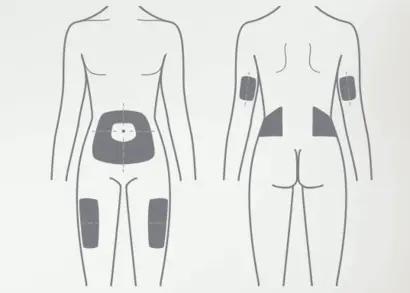6 Week Plan Ozempic Weight Loss Results

- 6 Week Plan Ozempic Weight Loss Results Success Stories
- 6 Week Ozempic Weight Loss Plan
- Week 1: Starting the Ozempic Journey
- Week 2: Monitoring Progress and Adjusting
- Week 3: Overcoming Challenges and Staying Motivated
- Week 4: Embracing Exercise and Boosting Metabolism
- Week 5: Refining Habits and Embracing Lifestyle Changes
- Week 6: Reflecting, Celebrating, and Planning for the Future
- Best Place to Inject Ozempic for Weight Loss
- Risks and Side Effects of Using Ozempic for Weight Loss
- Is Ozempic Safe for Long Term Use?
- Will I Regain the Weight After Stopping Ozempic?
- Resources
- Conclusion
- FAQs
This post may contain affiliate links, meaning I may earn a commission if you make a purchase, at no extra cost to you. I only recommend products I trust. Thank you for your support.
Ozempic, the brand name for the medication semaglutide, has taken the world of weight management by storm.
Initially developed to treat type 2 diabetes, this injectable drug has proven to be a game-changer for individuals struggling with obesity and excess weight.
But what sets Ozempic apart from traditional weight loss methods? The secret lies in its ability to mimic the effects of a naturally occurring hormone called glucagon-like peptide-1 (GLP-1).
By activating GLP-1 receptors in the body, Ozempic triggers a cascade of metabolic changes that promote weight loss.
It helps curb appetite, slows down gastric emptying, and enhances feelings of fullness, making it easier to consume fewer calories without constant hunger pangs.
However, it’s crucial to understand that Ozempic is not a magic bullet; it works best when combined with a balanced diet for weight loss and a regular exercise routine.
The 6 week Ozempic weight loss plan results has garnered significant attention for its breakthrough in weight management.
In this article. we shall provide you with a detailed 6 week plan Ozempic weight loss results, proven Ozempic weight loss before and after pictures, the best place to inject Ozempic for weight loss, and potential side effects of using Ozempic for weight loss.
6 Week Plan Ozempic Weight Loss Results Success Stories
While the 6 week Ozempic weight loss plan provides a structured approach to weight loss, it’s the real-life success stories that truly inspire and motivate.
Here are a few success stories with remarkable 6 week plan ozempic weight loss results from individuals who have embraced the power of Ozempic for weight loss with their Ozempic weight loss before and after pictures:

1. Gina Schweppe
Gina, a 36 year old mother of four, had struggled with her weight for years. At her heaviest, she tipped the scales at 200 pounds, and her self-confidence hit an all time low.
It wasn’t until she discovered Ozempic for weight loss that her health journey took a dramatic turn.
Combining Ozempic with a balanced diet and regular exercise, Gina lost an impressive 35 pounds in 3 months!
Her food cravings subsided, and she found herself making healthier choices without feeling deprived.
Today, Gina proudly shares her journey on YouTube, inspiring others to take control of their health and embrace a lifestyle that truly nourishes body and mind.

2. Pepper Schwartz
At 78 years old, a renowned sex and relationship expert Dr. Pepper Schwartz was determined to prioritize her weight loss journey.
Through the use of Ozempic for weight loss, she successfully shed over 30 pounds, showcasing the effectiveness of this treatment in supporting her weight management goals.
Dr Schwartz mentions that she is now more mindful in her approach to eating. The primary change she notes is a reduction in hunger, leading to a shift in how she perceives portion sizes.
Dr Schwartz also mentions that using Ozempic has helped to maintain a healthy blood pressure and cholesterol levels.
Pepper’s story serves as a powerful reminder that it’s never too late to embark on a journey towards better health.
Her commitment to making lifestyle changes, combined with the support of Ozempic, has allowed her to embrace her golden years with newfound vigor.
6 Week Ozempic Weight Loss Plan
After witnessing Gina and Schwartz achieve remarkable results with Ozempic, we’ve developed a 6-week Ozempic weight loss plan to kick-start your weight loss journey and help you achieve similar success.
The 6 week Ozempic weight loss plan results focuses on leveraging the medication’s weight loss benefits to achieve significant results.
This 6 week Ozempic weight loss plan combines Ozempic with a balanced diet and regular exercise, through which individuals can typically experience noticeable weight loss within this timeframe.
So, what are you waiting for? Here is a comprehensive 6 week plan Ozempic weight loss plan to get you started:
Week 1: Starting the Ozempic Journey
The first week of the 6 week Ozempic weight loss plan is all about acclimating to the medication and laying the foundation for sustainable lifestyle modifications.
Initiating Ozempic Treatment
- Schedule an appointment with your doctor to discuss starting Ozempic for weight loss and management.
- Your doctor will prescribe the appropriate dosage of Ozempic based on factors such as your weight, insulin resistance, and response to previous diabetes treatments.
- Typically, Ozempic is started at a low dose (e.g., 0.25 mg once weekly) and gradually increased over time based on your body’s response and blood glucose levels.
- It’s essential to follow the prescribed dosage and injection technique meticulously.
Adopting a Balanced Diet
- During this initial week, focus on gradually transitioning to a nutrient-dense, Ozempic diet.
- Emphasize whole, unprocessed foods, lean proteins, fibrous vegetables, and healthy fats.
- Stay hydrated by consuming plenty of water throughout the day.
Incorporating Light Exercise
- Start with light physical activity, such as 10-15 minutes of brisk walking, stretching exercise, or gentle yoga, can help kickstart your metabolism and promote overall well-being.
- Opt for activities that you find enjoyable and sustainable in the long term to stay motivated.
- Begin with short sessions of light exercise and gradually increase the duration and intensity as your fitness level improves.
- Set achievable goals for your light exercise sessions, such as a certain number of steps per day, a specific distance for walking or jogging, or a duration for yoga or stretching sessions.
- Pay attention to how your body responds to exercise and adjust your intensity or duration accordingly. Don’t push yourself too hard, especially if you’re just starting out.
Week 2: Monitoring Progress and Adjusting
As you enter the second week of the Ozempic weight loss plan, it’s essential to closely monitor your progress and make necessary adjustments to optimize your results.
Tracking Weight and Measurements
- Use a reliable and consistent scale for weighing yourself and a measuring tape for tracking body measurements (e.g., waist, hips, chest, arms).
- Establish a regular schedule for tracking your weight and measurements, such as once a week or every two weeks.
- Avoid excessive tracking, as daily fluctuations in weight and measurements are normal and can be misleading.
- In addition to weight and measurements, consider periodic body composition assessments (e.g., body fat percentage, muscle mass).
- Keep a dedicated journal, spreadsheet, or mobile app to record your weight, measurements, and any relevant notes (e.g., exercise, dietary changes).
- Understand that weight loss is not linear, and fluctuations in weight and measurements can occur due to various factors (e.g., hydration, food intake, hormones).
Adjusting Ozempic Dosage
- Provide feedback on your response to the medication, including any side effects or changes in blood glucose levels.
- Your doctor will evaluate your response to Ozempic and may adjust the dosage based on factors such as blood glucose control, weight loss progress, and tolerance to side effects.
- Be aware of potential side effects associated with Ozempic for weight loss, such as nausea, constipation, diarrhea, or injection site reactions.
Refining Dietary Habits
- Use smaller plates and bowls to control portion sizes and avoid overeating.
- Measure and weigh food portions initially to get a sense of appropriate serving sizes.
- Focus on filling half your plate with vegetables, a quarter with lean protein, and a quarter with whole grains or starchy vegetables.
- Consider spacing meals evenly throughout the day to maintain energy levels and prevent excessive hunger.
- Prioritize nutrient-dense foods such as fruits, vegetables, lean proteins, whole grains, and healthy fats.
- Limit processed foods, sugary snacks, and high-calorie beverages.
- Practice mindful eating by paying attention to hunger and fullness cues, eating slowly, and savoring each bite.
- Plan your meals and snacks ahead of time to avoid impulsive food choices.
- Consider keeping a food journal or using a mobile app to track your food intake, portion sizes, and calorie counts.
Week 3: Overcoming Challenges and Staying Motivated
As with any significant lifestyle change, the third week of the Ozempic weight loss plan may present its own set of challenges. Maintaining motivation and overcoming obstacles is crucial during this phase.
Identifying and Addressing Barriers
- Reflect on factors that may be hindering your weight loss progress, such as emotional eating, lack of motivation, stress, or unhealthy habits.
- Share your concerns openly and work collaboratively to develop personalized coping strategies.
- If emotional eating is a barrier, learn to recognize emotional triggers and develop alternative coping mechanisms such as journaling, mindfulness practices, or seeking emotional support from friends or a therapist.
- Work with a registered dietitian or personal trainer to establish healthy eating and exercise habits that are sustainable and enjoyable.
- Maintain a positive mindset, focus on self-care, and be kind to yourself during the weight loss journey.
Celebrating Non-Scale Victories
- While the scale can be a useful tool, it’s important to recognize and celebrate non-scale victories as well.
- Pay attention to changes in how your clothes fit and feel, such as looser waistbands, better fitting clothes, or needing smaller sizes.
- Improved energy levels, better sleep quality, or a newfound sense of confidence can be powerful motivators to keep you on track.
- Acknowledge boosts in self-confidence and body positivity as you make progress towards your weight and fitness goals.
- Take moments to express gratitude for the progress you’ve made and reflect on how far you’ve come in your weight loss journey.
Incorporating Mindfulness Practices
- Use mindfulness practices as tools for managing stress, reducing cortisol levels, and improving resilience to stressors.
- Set aside time each day for meditation sessions, even if it’s just a few minutes to start.
- Find a quiet and comfortable space where you can sit or lie down without distractions.
- Focus on your breath, body sensations, or a calming mantra to cultivate a sense of mindfulness and inner peace.
- Practice deep breathing exercises throughout the day, especially during moments of stress or anxiety.
- Apply mindfulness to your eating habits by paying attention to your food choices, chewing slowly, and savoring each bite.
- Try a body scan meditation where you systematically focus on each part of your body, from head to toe, relaxing and releasing tension as you go.
- Be consistent and patient with yourself as you explore mindfulness, allowing yourself time to develop and deepen your practice over time.
Week 4: Embracing Exercise and Boosting Metabolism
As you progress through the 6 week plan Ozempic weight loss results, it’s time to ramp up your exercise routine and explore strategies to boost your metabolism for sustainable weight loss.
Increasing Exercise Intensity
- Monday: 30 minutes of brisk walking or jogging and 20 minutes of kettlebell swings with rest periods
- Tuesday: 40 minutes of stretching or yoga (3 sets of 12 reps each)
- Wednesday: 30 minutes of brisk walking or jogging
- Thursday: 35 minutes of flexibility exercises such as lunges, planks, and shoulder presses (3 sets of 12 reps each)
- Friday: 30 minutes of brisk walking or jogging and 20 minutes of kettlebell swings with rest periods
- Saturday: 45 minutes of mixed cardio (cycling, swimming, or a fitness class) and 10 minutes of stretching
- Sunday: Rest day or light activity (leisure walk, gentle yoga)
Exploring High-Intensity Interval Training (HIIT)
- HIIT workouts, which involve short bursts of intense exercise followed by periods of rest, have been shown to be particularly effective for boosting metabolism and promoting fat loss.
- You can can start with 20 seconds of moderate intensity cycling followed by 40 seconds of slow pedaling.
- Combining bodyweight exercises like push-ups and lunges in a HIIT format (e.g., 30 seconds of push-ups, 30 seconds of rest, 30 seconds of lunges, 30 seconds of rest).
- Sprinting at maximum effort for 30 seconds followed by 1 minute of walking, repeated for 20 minutes, can elevate your metabolism long after the workout is over.
- Performing 20 seconds of jump squats, followed by 40 seconds of rest, for a total of 15 minutes, can burn a significant number of calories and target stubborn fat areas.
- A 15 minute HIIT routine consisting of 1 minute of high knees, followed by 1 minute of rest, repeated 7 times, provides a full workout in a fraction of the time.
- Alternating between 30 seconds of burpees and 30 seconds of rest for 10 rounds can significantly improve cardiovascular endurance and heart function.
Incorporating Resistance Training
- Building and maintaining lean muscle mass is crucial for a healthy metabolism and long-term weight management.
- You can start with bodyweight exercises such as squats and planks, while more advanced individuals can use free weights or resistance machines.
- Lifting weights three times a week can significantly boost your metabolism, helping you burn more calories throughout the day.
- Performing compound exercises like squats and deadlifts can help preserve muscle mass while losing fat.
- Doing bodyweight exercises like push-ups and lunges can improve functional strength, enhancing daily movement and stability.
- Incorporating exercises like deadlifts and overhead presses can strengthen bones and joints, promoting long-term skeletal health.
Week 5: Refining Habits and Embracing Lifestyle Changes
As you approach the final weeks of the 6 week Ozempic weight loss plan, it’s time to solidify the healthy habits and lifestyle changes you’ve cultivated throughout the journey.
Evaluating and Adjusting Meal Plans
- Ensure your meal plans provide a balanced mix of macronutrients (proteins, fats, and carbohydrates) and essential vitamins and minerals.
- Focus on incorporating foods that you enjoy and that keep you satisfied to make healthy eating a pleasant experience.
- Evaluate if your portion sizes are appropriate for your energy needs and weight management goals.
- Incorporate variety to prevent meal fatigue and ensure a wide range of nutrients such as rotating different vegetables, fruits, proteins, and whole grains in your diet.
- Reflect on the methods you use to prepare your food and consider healthier alternatives if needed.
- Make small, manageable changes rather than drastic overhauls to maintain sustainability.
Exploring New Physical Activities
- Consider activities that you find fun and engaging, which can help you look forward to your workouts.
- Joining group activities can provide social interaction and accountability, making exercise more enjoyable.
- Join new fitness classes (pilates, kickboxing, spin) to introduce you to new forms of exercise and provide structure to your workouts.
- Plan regular hiking trips to explore new trails and enjoy the benefits of nature while getting a good workout.
Developing a Maintenance Mindset
- As you approach the end of the 6 week Ozempic weight loss plan, it’s essential to shift your mindset from weight loss to weight maintenance.
- Use a calorie calculator to reassess your calorie needs to maintain your new weight rather than continue losing.
- Continue to prioritize nutrient-dense foods that provide essential vitamins and minerals while maintaining a balanced diet.
- Keep up with a regular exercise routine (at least 150 minutes per week), adjusting the intensity and duration as needed for weight maintenance.
- Regularly check your weight and body measurements to ensure you’re maintaining your results, but avoid becoming overly fixated on numbers.
- Surround yourself with a support system that encourages your healthy habits and helps you stay accountable.
Week 6: Reflecting, Celebrating, and Planning for the Future
The final week of the 6 week Ozempic weight loss plan is a time for reflection, celebration, and setting the stage for continued success.
Assessing Progress and Achievements
- Take a moment to think about the changes you’ve made and the challenges you’ve overcome.
- Look at photos from the start of your journey and compare them with current photos to see your transformation.
- Assess key health metrics such as weight, body measurements, blood pressure, and blood sugar levels to quantify your progress.
- Recognize and list the healthy habits you’ve developed, such as regular exercise, balanced eating, or improved sleep patterns.
- Take time to celebrate your accomplishments in a meaningful way.
- Use your reflections to set new, realistic goals that will keep you motivated and on track.
Sharing Your Success Story
- Use platforms like Instagram, Facebook, or TikTok to share your progress, insights, and tips.
- Join forums or groups dedicated to weight loss and healthy living to share your story and support others.
- Record weekly updates, workouts, meal preps, and Q&A sessions. Share your emotional and physical progress to create a personal connection with viewers.
- Write a testimonial for Ozempic for weight loss or any fitness program you used. Highlight how these tools contributed to your success.
- Give talks on your journey, the importance of a healthy lifestyle, and practical tips for others looking to make similar changes.
Setting Long-Term Goals
- While the 6 week Ozempic weight loss plan may be coming to an end, your journey towards optimal health is just beginning.
- Set long term goals that align with your values and aspirations by reflecting on what matters most to you in terms of health, fitness, and overall well-being.
- Set specific and measurable goals for example; instead of a vague goal like “lose weight,” set a specific goal such as “maintain my current weight within a 5-pound range.”
- Identify key health metrics to monitor regularly, such as weight, body fat percentage, blood pressure, cholesterol levels, and blood sugar levels.
- Prioritize balanced nutrition, regular physical activity, adequate sleep, stress management techniques, and consistent medical check-ups.
Exploring Weight Maintenance Options
- Discuss with your doctor the option of continuing Ozempic as part of your long term weight management plan.
- Explore alternative weight management medications if continuing Ozempic is not recommended or if you’re looking for different options.
- If you prefer not to rely on medications for weight maintenance, focus on maintaining a balanced diet, regular physical activity, adequate sleep, stress management, and other healthy habits.
- Stay informed about nutrition, exercise, and overall wellness through reputable sources and educational resources.
- Be open to adapting your maintenance plan based on changes in your lifestyle, health status, or goals. Flexibility and willingness to adjust as needed can contribute to long-term success.

Best Place to Inject Ozempic for Weight Loss
The recommended injection sites for Ozempic for weight loss are typically the abdomen, thigh, or upper arm.
Here’s a detailed guide for the best place to inject Ozempic for weight loss:
1. Abdomen
- Locate a site at least 5 centimeters (2 inches) away from the belly button.
- Choose an area with a pinchable layer of fat.
- Avoid the area around the waistline, as well as scars or stretch marks.
2. Thigh
- Select the front of the thigh, about 10 to 15 centimeters (4 to 6 inches) below the top of the thigh and 10 to 15 centimeters (4 to 6 inches) from the knee.
- Avoid injecting into areas with scars, blemishes, or broken or irritated skin.
3. Upper Arm
- Use the back of the arm, between the shoulder and the elbow.
- Avoid injecting into areas with scars, blemishes, or broken or irritated skin.
Risks and Side Effects of Using Ozempic for Weight Loss
Using Ozempic for weight loss should only be done under the guidance of a healthcare professional due to potential risks and side effects.
Here are the potential risks and common side effects of using Ozempic for weight loss:
1. Gastrointestinal Effects
- Nausea
- Diarrhea
- Vomiting
- Constipation
- Abdominal pain
2. Hypoglycemia
- Due to the glucose lowering effects of Ozempic, there is a risk of hypoglycemia, especially when used with other blood sugar lowering medications.
3. Pancreatitis
- In rare cases, pancreatitis (inflammation of the pancreas) has been reported. Symptoms may include severe abdominal pain that may radiate to the back and may be accompanied by nausea and vomiting.
4. Thyroid Tumors
- In animal studies, Ozempic has been shown to increase the risk of thyroid tumors. While this risk has not been confirmed in humans, it’s a potential concern.
5. Bone Fractures
- There is a potential risk of bone fractures, particularly in individuals with a history of fractures or those at risk for osteoporosis.
Is Ozempic Safe for Long Term Use?
The Long term use of Ozempic is considered safe, but there are concerns about its impact on cardiovascular health and intestinal obstructions. Some users have reported heart related issues, and the FDA warns about the risk of blocked intestines.
Patients with heart conditions should discuss these risks with their doctors before using Ozempic long term.
Will I Regain the Weight After Stopping Ozempic?
Yes, studies indicate that individuals may regain two-thirds of lost weight within a year after discontinuing Ozempic, a phenomenon often referred to as “Ozempic rebound.”
The key is to use the 6 week Ozempic weight loss plan as a catalyst for developing sustainable lifestyle habits that can be maintained long after the medication is discontinued.
Resources
- Weight loss outcomes associated with Ozempic
- Ozempic weight loss results for obese patients
- Ozempic weight management in obesity
Conclusion
After diligently following the 6 week Ozempic weight loss plan, it’s evident that significant progress has been achieved.
The 6 week plan Ozempic weight loss results demonstrate a remarkable transformation in both physical appearance and overall well-being.
The journey exemplifies the effectiveness of Ozempic for weight loss and underscores the potential for achieving substantial health improvements within a relatively short timeframe.
The success stories of this 6 week Ozempic weight loss plan serves as a testament to the efficacy of this approach and provides inspiration for others embarking on similar paths toward better health.
In conclusion, the 6 week Ozempic weight loss plan has empowered the individuals to embrace a healthier lifestyle, setting a profound example of the transformative impact achievable through dedication, perseverance, and a comprehensive approach to wellness.
- 7 foods to avoid with UTI
- Foods to avoid while on Saxenda
- Best vitamins for pituitary gland
- Cancer foods to avoid
- Foods to avoid while breastfeeding
- Food to avoid while taking Contrave
- 7-day low sodium meal plan
- Avoid these foods if your alkaline phosphatase is high
- Foods to avoid while taking Trulicity
- 7-day meal plan for low potassium diet
- 7-day Daniel fast meal plan
- 7-day meal plan for prediabetes
FAQs
How fast does Ozempic work for weight loss?
Ozempic for weight loss results show after 3 months of treatment, patients experienced a mean weight loss of 6.7 kg, equivalent to a mean weight loss of 5.9%.
Furthermore, after 6 months, the mean weight loss was 12.3 kg, equivalent to a mean weight loss of 10.9%
Who can prescribe Ozempic for weight loss?
Ozempic for weight loss is typically prescribed by healthcare professionals for individuals with type 2 diabetes at risk of cardiovascular problems.
While it is not FDA approved specifically for weight loss, some doctors may prescribe it off-label for this purpose.
Does Ozempic help to reduce belly fat?
Yes, Ozempic can help reduce belly fat. Research indicates an average weight loss of 7.5% and a decrease in waist circumference by 5.09 cm with Ozempic use.
Additionally, a study of nearly 2,000 overweight or obese adults without diabetes found that semaglutide reduced visceral fat, including belly fat.
What is the typical weight loss with Ozempic in 3 months?
After 3 months of Ozempic treatment, the study reported a mean weight loss of 6.7 kg, which is equivalent to a mean weight loss of 5.9%.




